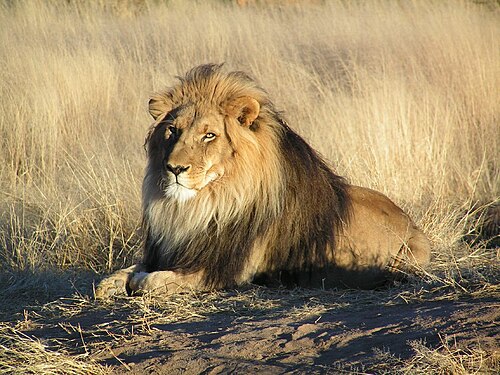The lion (Panthera leo) is a large cat and is known as the "King of the Forest". It is the second largest living cat, after the tiger. Lions are primarily found in sub-Saharan Africa and small parts of Asia (such as the Gir Forest in India), although they once had a wider range, including Europe, Asia, and the Americas.

Size: Adult male lions usually weigh 150 to 250 kilograms, can reach 2 to 3 meters in length (including tail), and are about 1.2 meters tall at the shoulder. Female lions are smaller, usually weighing 110 to 180 kilograms.
Appearance: Male adult lions have a mane, the most distinctive feature of their gender, which ranges in color from light yellow to black and becomes thicker and darker with age. Female lions have no manes.
Lifespan: The lifespan of a wild lion is usually around 10 to 14 years, but in captivity they can live more than 20 years.
Sociality: Lions are the only cats that live in groups, and they often form "pride" groups, which may include up to 30 lions, consisting of several males and more females and cubs.
Territoriality: Lions have a well-defined territory and will defend their territory from intrusion by other prides.
Hunting: Female lions are responsible for most of the hunting work. They use group cooperation to hunt, mainly hunting various herbivorous animals, such as wildebeest, zebra, antelope and buffalo. Male lions occasionally join in the hunt.
Communication: Lions communicate with each other in a variety of ways, including roaring to demonstrate or communicate with the group. Facial expressions, body language and touch are also part of their communication.
Breeding Season: Lions do not have a fixed breeding season, but the males of the pride will mate with the female when she is in heat.
Gestation and pups: The gestation period is approximately 110 days, and a litter usually contains 1 to 4 pups. Newborn lion cubs are very fragile and need to be closely cared for by the lioness in a hidden place until they are old enough before being brought into the pride.
Lion numbers have declined significantly over the past few decades due to habitat loss, human-wildlife conflicts, hunting and disease. Lions are currently listed as vulnerable or threatened in many of their native areas and are already extinct in some areas.
Conservation work: Lion conservation work includes protecting their habitat, reducing conflicts between farmers and herdsmen and lions, and combating illegal hunting and trade activities. Meanwhile, national parks and nature reserves provide relatively safe environments for wild lions.
Lions have an important place in human culture as they are used as symbols of courage, strength and kingship. However, human-lion conflict has a long history and remains a significant problem in some areas due to the potential threat lions pose to livestock and human life.
Maintaining the survival of lions is not only important for biodiversity conservation, but also for maintaining a stable and healthy ecosystem. Therefore, continuously strengthening environmental protection and promoting related protection awareness are current key tasks.
animal tags: lion
We created this article in conjunction with AI technology, then made sure it was fact-checked and edited by a Animals Top editor.